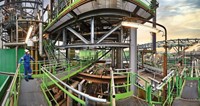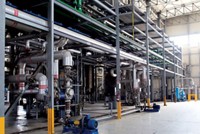Advertisement
Grab your lab coat. Let's get started
Welcome!
Welcome!
Create an account below to get 6 C&EN articles per month, receive newsletters and more - all free.
It seems this is your first time logging in online. Please enter the following information to continue.
As an ACS member you automatically get access to this site. All we need is few more details to create your reading experience.
Not you? Sign in with a different account.
Not you? Sign in with a different account.
ERROR 1
ERROR 1
ERROR 2
ERROR 2
ERROR 2
ERROR 2
ERROR 2
Password and Confirm password must match.
If you have an ACS member number, please enter it here so we can link this account to your membership. (optional)
ERROR 2
ACS values your privacy. By submitting your information, you are gaining access to C&EN and subscribing to our weekly newsletter. We use the information you provide to make your reading experience better, and we will never sell your data to third party members.
Business
Europe’s Biomaterial Firms Struggle To Scale Up
Sector seeks regulation change to encourage financing for commercial plants
by Alex Scott
October 21, 2013
| A version of this story appeared in
Volume 91, Issue 42

After long journeys of scientific discovery, European industrial biotechnology firms are beginning to move their technologies for making biobased chemicals from the lab into commercial production. But there’s a problem: The money to pay for costly and financially risky large-scale manufacturing facilities is scarce.
Many of the 600 delegates who met at the European Forum for Industrial Biotechnology & the Biobased Economy (EFIB) in Brussels earlier this month are concerned that if Europe doesn’t better support biomaterial firms with financial incentives and business-friendly policies they could fail or move in droves to countries such as the U.S. and Canada. European officials at the event rejected such criticism and said that they are enabling the commercialization of biobased chemicals through a range of initiatives including participation in production scale-up.
To attract investment for building commercial plants, companies need a clear path to profitability, said a stony-faced Stephan B. Tanda, board member of the Dutch firm DSM, during a panel discussion on Europe’s ability to create a bioeconomy. To reduce financial risk and give firms a better chance of getting their processes out of the lab and into commercial use, Europe’s biotech industry needs to work with governments to foster public-private partnerships, he said.
Executives speaking at various forum sessions and during coffee breaks emphasized that the industry also needs legislation encouraging the agricultural sector to gather biomass as a chemical raw material. And it needs a European public that is educated about the environmental benefits of shifting from an oil-based to a biobased economy.
“Yes, we have what it takes in Europe. We have the technologies, but now we are at the crossroads where we have to decide whether to deploy this technology,” said Lars Hansen, European head of Novozymes, a leading enzyme producer.
Gloria Gaupmann, regulatory affairs manager at chemical maker Clariant, was one of several industry executives frustrated by the failure of the European Union to support technology commercialization by, for example, recognizing the climate-change benefits of biobased chemicals. Clariant is operating a demonstration plant for its Sunliquid cellulosic ethanol process in Straubing, Germany. Ethanol produced using the process has a 95% greenhouse gas emissions savings compared with gasoline, according to Clariant.
But the company’s plans to license the technology are being stymied by certain EU policies, as well as its failure to establish strong carbon dioxide reduction targets, Gaupmann said. The region needs incentives dedicated to cellulosic technologies—those that make fuels from inedible instead of edible biomass—she said. “We have done our part to develop the technology. The EU still has homework to do. There is a need to restore investors’ confidence in the market.”
In addition to a general lack of support, the EU’s protectionist agricultural policies are another obstacle in the way of industrial biotech firms, said Claude J. Stoufs, partner with Capricorn Venture Partners, a Belgian venture capital firm. If a firm needs to import sugar into the EU, for example, it must pay double the international price as a result of duties, Stoufs said.
In contrast to what is happening in Europe, governments in other regions, including those in North America, are more adept at ensuring that companies have access to funding when they need it, according to Jos B. Peeters, a managing partner at Capricorn. A prime example is the U.S. subsidy for bioethanol under the Renewable Fuel Standard.
“When compared with the EU, in the U.S. there are incentives for the market,” Peeters said. “In the EU, you tend to have many sticks and few carrots to make the move from lab to commercial scale. If this is not addressed, all of the technology companies that have pilot plants will have to move to the U.S.”
BioAmber, which developed a biosuccinic acid process and operates a pilot facility in Pomacle, France, is an example of a firm set to migrate its commercial manufacturing to Canada. BioAmber will receive a one-time payment of $12 million from the Ontario government to build its first commercial succinic acid plant in Sarnia. Total costs for the proposed plant, which is due to open at the end of 2014, will be about $110 million.
But it can be tough to raise funds in Europe. “It’s going to take major steps to invest in significant scale-up. You need partners,” said John Davis, a director at the European Investment Bank. Its current per-project minimum is about $70 million, which Davis acknowledged is high for many start-ups.
Another option for industrial biotech companies looking to commercialize technologies is “going to the market,” said Denis Lucquin, managing partner for Paris-based venture capital firm Sofinnova Partners. Pharma biotechs often float shares on European stock markets to raise the $200 million or so needed to pay for drug candidate clinical trials. This amount is similar to what is needed to build a commercial chemical plant, he said.
But after announcing plans to build its succinic acid plant in Canada, BioAmber opted to go public on the New York Stock Exchange, where it raised $80 million.
European regulators hit back at suggestions that they are failing to support biochemical commercialization in the region. “I think we have been accused of almost being a museum here. But that is not true. We are commercializing,” said Antonio Di Giulio, acting director of biotechnology, agriculture, and food for the European Commission’s research and innovation unit.
The commission has targeted sales of biobased chemicals in Europe of about $200 billion by 2030, equivalent to about 30% of all chemical sales. To catalyze the growth of the sector, EU regulators are poised to back the investment of about $5.4 billion into industrial biotech R&D as part of the region’s flagship research program, Di Giulio said. That program is set to get under way in 2014.
Of the $5.4 billion, $1.4 billion will be directed to the EU’s Joint Technology Initiative (JTI) on biobased industries, a public-private partnership. To get the $1.4 billion, industry will have to invest an additional $3.8 billion. JTI’s planned activities include support for precommercial-scale production facilities. “We are doing this investment to ensure that all this technology is developed and stays in the EU,” Di Giulio said.
JTI is needed to help bring different sectors together, develop a range of product types, pool resources, and cut the risks for investors, said Barend Verachtert, acting head of the commission’s biotechnology unit. “We are truly talking about partnerships with industry. There is ambition.”
One of the major issues that EU regulators have yet to fully address is how to create a supply chain that gets raw material biomass, such as crop residues and forestry sector waste, to companies that need it. Given Europe’s limited fertile land, it will be important for the EU to develop policies that align the goals of biomass suppliers with those of biobased chemical makers, industry experts say. Otherwise, disputes over land could emerge.
“We are already starting to see biomass disputes,” said Jim Philp, science and technology analyst at the Organisation for Economic Co-operation & Development, a Paris-based international agency. “The EU has got to sort out whom we source our biomass from. Imagine if it all grinds to a halt because of this.”
The task is not straightforward. Unlike the oil and gas sector, which is highly concentrated, the agriculture and forestry sectors from which biomass would be sourced are highly fragmented with potentially millions of forest owners across Europe, he said.
For participants in a sector on the cusp of commercialization, the biomaterials elite at EFIB were engaging in an extraordinary amount of hand-wringing as well as griping about the EU. Although industry broadly welcomes the European Commission’s creation of public-private partnerships, plenty of industry insiders said such initiatives fall short of what is required to get biotech processes across the so-called valley of death and into commercial use.
As Hansen of Novozymes cautioned, “Partnerships can only take us so far.”




Join the conversation
Contact the reporter
Submit a Letter to the Editor for publication
Engage with us on Twitter